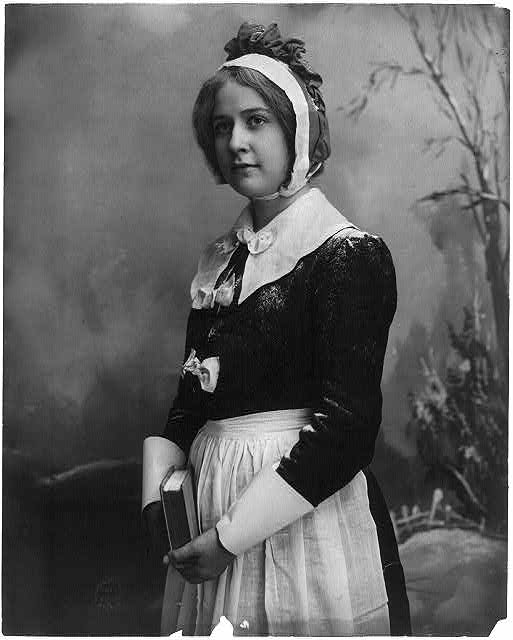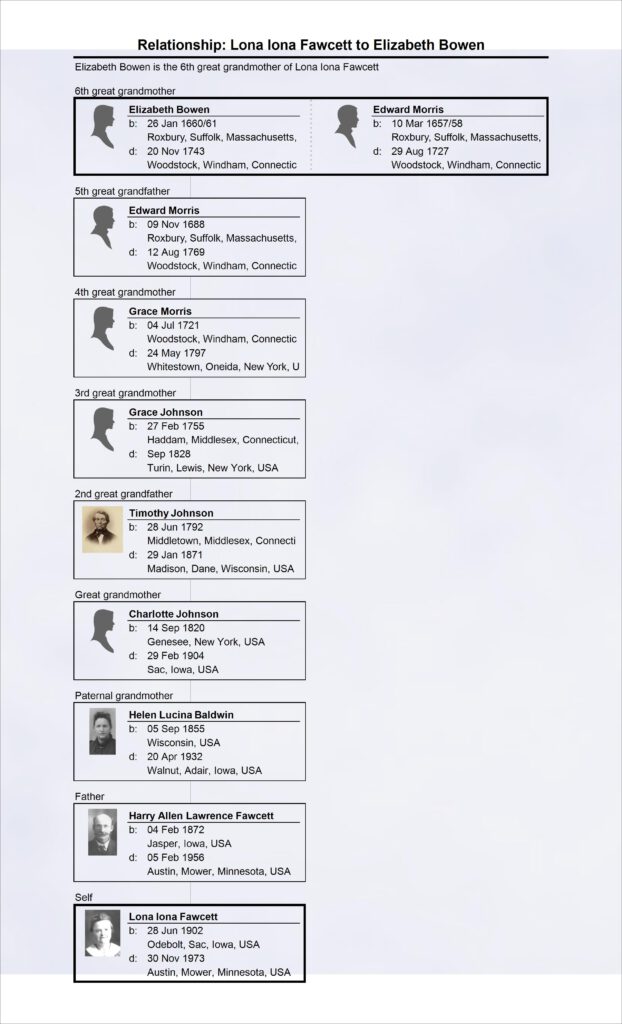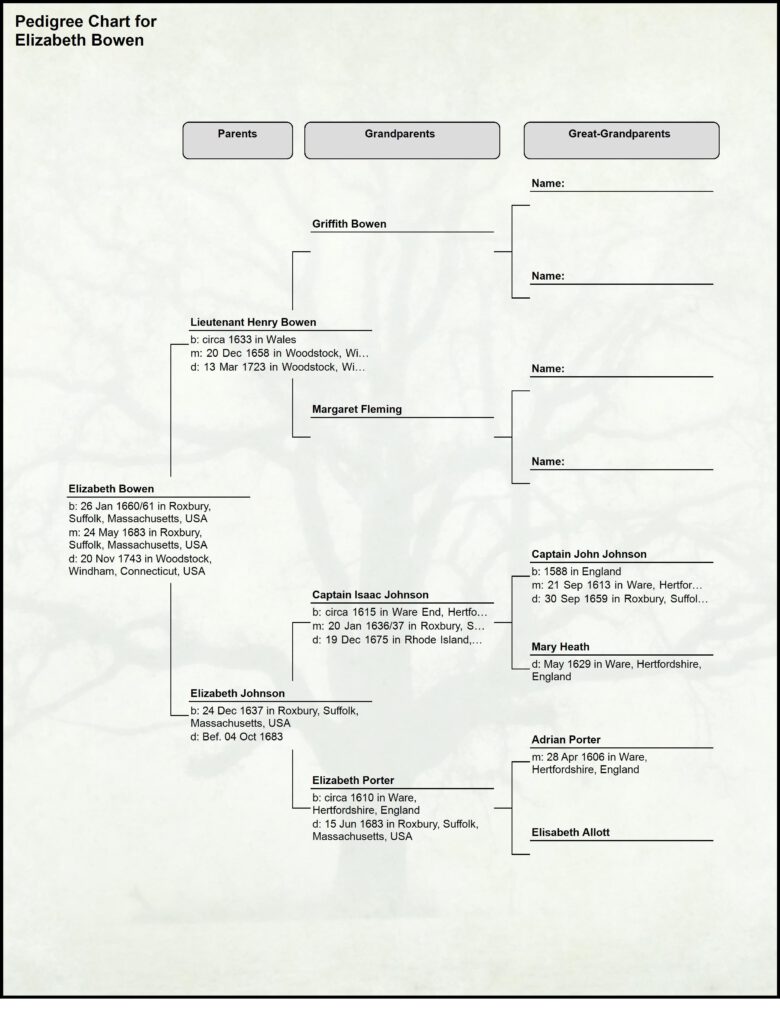Elizabeth Bowen Morris (1661-1743)
Elizabeth Bowen was born on 26 Jan 1660/61 in Roxbury, Suffolk, Massachusetts, as the second child of Henry Bowen and Elizabeth Johnson. She had nine siblings, namely: Henry, John, Margaret, Maria, Margaret, Abigail, Penuel, Esther, and Isaac. Elizabeth Bowen was baptized on 27 Jan 1660/1, a day after she was born, in Roxbury, Suffolk, Massachusetts.
[Before we really get started, here is a note about place names… the names listed are what the places are called now. When Elizabeth was alive we did not have states or even have thirteen colonies. The New World was just being settled and boundaries were just beginning to be drawn.]
When she was 22, Elizabeth Bowen married Edward Morris, son of Edward Morris and Grace Bett, on 24 May 1683 in Roxbury, Suffolk, Massachusetts. Elizabeth formally joined the church on 26 Oct 1688 and Edward on 1 May 1691.
Edward Morris and Elizabeth Bowen had the following children:
- Elizabeth Morris was born on 12 Feb 1684 in Roxbury, Suffolk, Massachusetts. She died on 19 Feb 1685 in Roxbury, Suffolk, Massachusetts (Age: 1).
- Elizabeth Morris was born on 09 Feb 1686 in Roxbury, Suffolk, Massachusetts. She married John Bartholomew on 28 Jan 1703 in Woodstock, Windham, Connecticut. She died on 17 Mar 1704 in Woodstock, Windham, Connecticut (Age: 18).
- Edward Morris was born on 09 Nov 1688 in Roxbury, Suffolk, Massachusetts. He married Bethiah Peake on 12 Jan 1715 in Woodstock, Windham, Connecticut. He died on 12 Aug 1769 in Woodstock, Windham, Connecticut (Age: 80).
- Grace Morris was born on 14 Nov 1692 in Woodstock, Windham, Connecticut. She married Joseph Peake on 09 Jan 1718. She died about Nov 1718 in Woodstock, Windham, Connecticut (Age: 25).
- Abigail Morris was born on 25 Oct 1694 in Woodstock, Windham, Connecticut. She married John Frizzel on 10 Nov 1726.
- Susanna Morris was born on 16 Aug 1698 in Woodstock, Windham, Connecticut. She married John Church on 01 Oct 1736.
- Prudence Morris was born on 09 Aug 1702 in Woodstock, Windham, Connecticut. She married Joseph Belknap on 17 Mar 1724/25.
Elizabeth and Edward started their married life in Roxbury.
In 1684, Edward’s dad, Edward Morris, and three other men were sent as a committee of four, to view the wilderness and find a convenient place for a new settlement. On 5 April 1686, a site was selected for the town of Woodstock. At the time, it was part of the Massachusetts Bay Colony. Note that it was not until 1749, after Elizabeth and Edward’s lives, that the town became part of the Connecticut Colony. Elizabeth’s dad, Henry Bowen and Edward’s dad, Edward Morris, were among the men known as the Thirteen Goers who founded Woodstock, which was first called the Town of New Roxbury. It was the first European settlement in the area that eventually became Windham County.
Elizabeth and Edward moved to Woodstock after his father died in September 1690. Edward took his father’s place there as a leader in town and church affairs. The town was just getting started. They had to lay out roads, build a grist-mill and saw-mill, build bridges, find people to live there, call a minister and built a meeting house (there was no separation of church and state at the time) and do everything they could to make it a permanent settlement.
They also set up the local government and elected selectmen. Everyone, well all men that is, were expected to participate.
“At the time, the men of Woodstock imposed a fine of one and six pence upon everyone who failed to attend the town meeting, and six pence an hour for tardiness.”
There were Indian troubles from 1690 to 1700 and the town of Woodstock didn’t grow as much as it expected. The area had previously been a hunting and fishing area for Native Americans, so when they returned, to hunt and fish, and found a town there, it was not good. Many of Woodstock’s families also sent men to fight under Captain Isaac Johnson, of Roxbury, in King Philip’s War. These included Bowen and Morris family members. During this time, the Woodstock townspeople were scared and received some military assistance from the colonial government, but the worries discouraged other people from coming to the town to settle.
During those years, the townspeople felt a great burden having to support war efforts, the church, and pay for a minister. In 1705, Edward became a Deacon in the church. By 1720, the people in Woodstock decided to build a new meeting house. The meeting house specifications included the following.
“The pulpit was to be of suitable size, with quarter-round wainscot and fluted pilasters each side of its window. The deacon’s seat, sounding board, and minister’s pew were of the same work as the pulpit. The minister’s pew was at the east end of the pulpit; at the west end were stairs with banisters, and the communion table. In front a body of seats was placed in the center of the house, the fore part quarter-round wainscot, and the hind part plain. The lower windows were cased after the present fashion; the walls ceiled with boards to the lower windows. Six pillars were turned and set under the gallery. A breast work of timber was put in front of the gallery; the stairs were half plastered and wholly banistered. The space around the walls was reserved for pews.”
Woodstock really couldn’t afford the meeting house they built, so they tried to get people in Roxbury to help pay for it through a tax. That didn’t go over very well. The people of Roxbury didn’t think they should have to contribute since they weren’t consulted in the matter before the church was built.
…although “they were glad to hear that the Woodstock people had built a handsome and convenient building for the public worship of God and believe that such a work could not be carried on without considerable charge — they could but think four or five hundred pounds at most, well laid out, might have built a very sufficient meeting-house for Woodstock, and are surprised that the petitioners should mention the sum of six hundred and seventy pounds. Since many large meeting-houses in the country, especially in the remote towns had been built for a much less sum, and it had better become the good people of Woodstock to have first sat down and counted the cost before they had begun so great and chargeable a work.”
Woodstock was left to pay for its own handsome church. Elizabeth, Edward, and their children got to enjoy it. Because their home was the closest house to the church, Edward, known as Deacon Morris, was appointed to “look after the meeting house, see that it be swept, and to keep a key, and take care of the cushing for twenty shillings a year.” I wonder if Edward did the sweeping himself. It seems likely that Elizabeth got stuck blessed with that task.
Elizabeth became a widow on 29 August 1727 when Edward passed away. He was buried in Woodstock Hill Cemetery. About a year before his death, Edward had deeded his estate to his only son, Edward, making provisions that Elizabeth be taken care of for the rest of her life.

Life was probably not very easy for Elizabeth. Women and children were treated harshly in Puritan society. Males were considered superior and women were considered instruments of Satan. Of their seven children, Elizabeth only gave her husband one son. That probably was very disappointing. Women were subordinate to men. They could not own property and, in that society, children were property, so a woman didn’t even ‘own‘ her own children. Elizabeth would have had to dress modestly, covering her hair and arms. Church would have been an extremely important part of her life. Inside, and out of, the meeting house, there were strict rules to follow. But interestingly, the Puritans believed in predestination, so no amount of good behavior on earth would change the plan that God had already chosen for a person as to whether they would end up in heaven or hell.
Elizabeth Bowen Morris died on 20 Nov 1743 in Woodstock, Windham, Connecticut at the age of 82. She was buried with her husband at Woodstock Hill Cemetery, Woodstock, Windham, Connecticut.
Where is she in the tree?


Sources:
Ancestry.com, Connecticut, Hale Cemetery Inscriptions and Newspaper Notices, 1629-1934 (Online publication – Provo, UT, USA: Ancestry.com Operations, Inc., 2012.Original data – The Charles R. Hale Collection. Hartford, Connecticut: Connecticut State Library.Original data: The Charles R. Hale Collection. Hale Collection of Connecticut Cemetery).
Ancestry.com, Massachusetts, Town and Vital Records, 1620-1988 (Online publication – Provo, UT, USA: Ancestry.com Operations, Inc., 2011.Original data – Town and City Clerks of Massachusetts. Massachusetts Vital and Town Records. Provo, UT: Holbrook Research Institute (Jay and Delene Holbrook).
Bowen, Clarence Winthrop. Woodstock, an Historical Sketch. New York: G.P. Putnam’s Sons, 1886. Image copy. Google Books. https://books.google.com/books?id=k_oBAAAAYAAJ : 2017.
Morris, Jonathan Flynt. A genealogical and historical register of the descendants of Edward Morris of Roxbury, Mass., and Woodstock, Conn.. Hartford: Morris, 1887.
Morris, Tyler Seymour, Ephraim and Pamela (Converse) Morris [google books] (Chicago, 1894), google Books: books.google.com.
MacLean, Maggie, “History of American Women: Puritan Women’s Rights,” Women History Blog, 16 Oct 2007, Web, 25 Jan 2017, http://www.womenhistoryblog.com/2007/10/puritan-women.html.
“History of Woodstock: A Brief History of the Town of Woodstock, CT,” Web, 25 Jan 2017, https://www.townofwoodstock.com/history/history-of-woodstock.html.


Leave a Reply